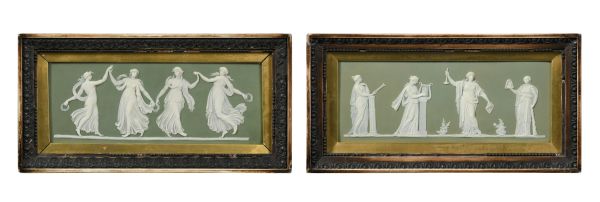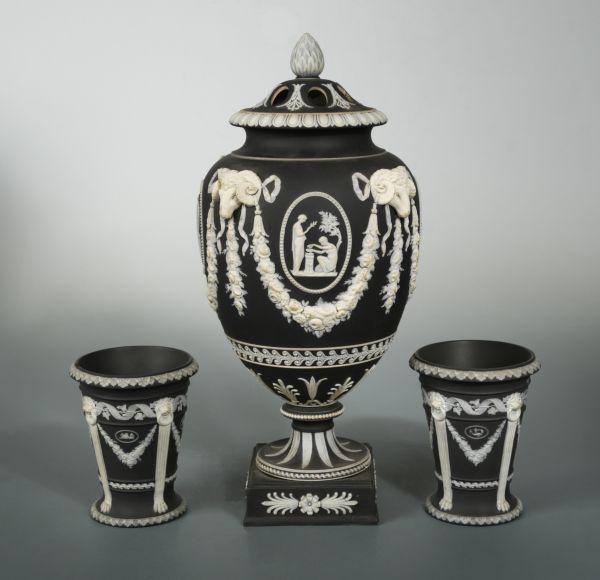TRENDSPOTTER: Jasperware
Brett Tryner explains why Jasperware is a hot ticket in today’s ceramics market
22/07/2025 Ceramics & Glass
As Wedgwood celebrates its 250th anniversary of Jasperware this year, we thought it fitting that we dig deeper into its history and its performance at auction. As a company only fifty years older than ourselves, Wedgwood has gone big on the anniversary celebrations, creating a new series which are being called ‘the icons’ and also the Jasper 250 platform – an interactive tool where people can create their own jasperware designs using AI.
It's the early pieces of jasperware which really hit the spot for top level antiques ceramics collectors, and this unique genre has a massive collecting market, throughout the UK and internationally.
Jasperware, with its recognisable blue, green or lilac colouring and neo-classical motifs is some of the most iconic and easily identifiable English pottery to have ever been created. In the creation of jasperware, Josiah Wedgwood was copying antiquity, with designs based on the Grand Tour iconography which was so popular in the late 18th century. This is partly what makes it still so popular today. The Grand Tour was the ultimate rite of passage for the British gentry throughout the 18th and 19th centuries and any items which reflected the iconography seen during that period was eminently popular with the great and good of the period. As these items became the pinnacle of taste, they formed the basis of the modern-day antique collecting market and whilst they have never fallen out of favour, today’s interiors tastemakers are increasingly using motifs inspired from these epic journeys throughout Europe in modern day design which has helped to ensure jasperware’s continued popularity. Created in the same year Jane Austen was born, jasperware is a staple part of regency interiors. It quickly became the centrepiece of ceramics collections worldwide, having been displayed on the shelves of homes across the country since its first conception in 1775. Jasperware is characterised by its matte finish, typically in a pale blue, which is known as ‘Wedgwood Blue’ and is synonymous with the brand today. It was also created in lilac tones, pale greens, pinks and occasionally in black.

A pair of Wedgwood green jasperware plaques, sold at Cheffins for £360
Unusually, jasperware has been produced consistently since its conception over 250 years ago, which is a testament to its continued charm and popularity. It has never gone out of fashion, and the best in class of the 18th century examples can achieve well into the thousands. The more modern examples of jasperware are readily available at auctions up and down the country and regularly feature in our monthly interiors sales here at Cheffins. As it was produced so frequently by Wedgwood over the years, modern examples of jasperware tend not to hold a huge amount of value, and are regularly offered in grouped lots at auction, along with other pieces of Wedgwood. Jasperware can include plates, teapots, sugar bowls, dressing table items, plaques, display plates, vases, urns, biscuit tins or even cufflinks. Some of the best examples of early pieces can be seen in the V&A which has an extensive Wedgwood collection and is well worth a visit for those interested in the history of British pottery.

A Wedgwood black jasperware neoclassical pot-pourri vase and cover and a pair of vases, sold at Cheffins for £500
Original pieces from the 18th century, however, can be worth far more achieving into the thousands for the best and most unusual pieces. For those looking to buy jasperware, it is best to look for the colours which were less mass-produced, such as the greens, blacks or lilacs. Original pieces will be smooth to the touch, uniform in colour, and have well-defined edges to the relief designs. It is important to look out for the classic Wedgwood mark, which sometimes for the earlier pieces will have variations and can be labelled ‘WEDGWOOD,’ ‘Wedgwood & Bentley’ or ‘W&B’.
Jasperware is particularly popular with American collectors, with a number of major collections being held across the pond. As well as in the UK, there are plenty of Wedgwood fans out there who look to amass major collections. Jasperware will always form the cornerstone of any major collection, and will continue to be an iconic example of the workmanship of Wedgwood. One of the joys of jasperware is it is so easily identifiable, with its iconic forms and neo-classic motifs.
Keep an eye on the regular Cheffins auctions by viewing the calendar here